
Shots fired by Indian, Chinese troops ahead of Jaishankar-Wang Yi meet
Indian and Chinese troops were engaged in a firing incident – up to 100-200 shots were fired in the air – on the north bank of Pangong Tso before External Affairs Minister Jaishankar and his Chinese counterpart Wang Yi reached a five-point consensus to de-escalate tensions on September 10

Indian and Chinese troops were engaged in a firing incident – up to 100-200 shots were fired in the air – on the north bank of Pangong Tso before External Affairs Minister Jaishankar and his Chinese counterpart Wang Yi reached a five-point consensus to de-escalate tensions on September 10, The Indian Express has reported.
The paper quoted a top government officer, who said the latest incident took place during a scramble for dominating the Fingers (spurs) on the north bank of the lake. According to the officer, “100 to 200 shots” were fired in the air by both sides on the ridgeline where Finger Firing incident
3 and Finger 4 merge before moving north as one ridge.
On September 7, the two countries acknowledged a firing incident, first time in decades, which took place in the Chushul sub-sector on a feature called Mukpari Heights.
The next round of talks between Corps Commanders of the two sides is awaited, it is not of the same levels as they were in the first week of September, the officer was quoted as saying.
“In the first week of September, there was a lot of movement” on both the north and south banks of Pangong Tso, the officer said, mentioning “multiple” incidents of firing in the region in the first week of the month.
In the week after the night of August 29-30, when Indian troops preempted PLA moves and out-manoeuvred them to occupy certain heights along the LAC, there were continuous attempts by the Chinese to “dislodge” Indian troops from these previously unmanned locations.
At several positions in the Chushul sub-sector, on Pangong Tso’s south bank, the Indian and Chinese troops are less than 300 metres apart.
Over the next week, India readjusted its positions on the north bank of the lake as well — Chinese troops have been sitting on the ridge of Finger 4, which is 8 km west of Finger 8 which India says marks the LAC.
It was during these times that Indian and Chinese troops fired around 100 rounds each, in the air. In this area too, troops from two sides are positioned less than 500 metres from each other.
Related news: China illegally occupying 38,000 sq km in Ladakh: Rajnath tells Parliament
The situation, however, has since calmed down, the officer said. “Now things have cooled down because of the talks between our Defence Minister and their Defence Minister and the Foreign Ministers. The focus has shifted towards dialogue,” he said.
“At the moment, the intimidation and aggression have stopped. The level (of discussions) has gone a little higher. Military commanders will talk, of course, we will put across our point, they will put across their point. But I don’t think their military commander will have the mandate to agree to anything beyond a minor concession,” the officer said.
According to the officer quoted by the paper, before India occupied the heights along the LAC in the Chushul sub-sector, China was in a position of advantage, and at the discussions at the military and diplomatic levels, “they were trying to bargain for time” as “at that particular stage they were better off” and “they had no reason to negotiate”.
“The Chinese were trying to do similar activity on the south bank” of the lake when Indian forces pre-empted their move. Now, the heights where Indian troops are positioned “are between the two lines” of the differing perceptions of LAC of the two countries.


